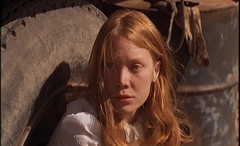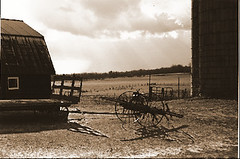Sound & Sympathy in Terrence Malick's Badlands (1973)
Terrence Malick's haunting, lyrical re-envisionment of the 1950s Starkweather-Fugate killing spree provides an interpretative and non-judgmental perspective of what it might have been like for a fifteen-year-old girl to have absconded with her father's murderer and passively participate with the subsequent domino-like murders that followed. Through a combination of sound techniques, the subtler, more nuanced aspects of the story help to shed light on how a situation like that might have played out in real life. Told in a sparse voice-over with a reflective journal writing-like quality and a series of non-traditional sound choices, Badlands manages to convey the empty, nowhere feel of a small town where boredom might prevail over reason.
Malick shows that ennui like a hairline fracture, separating its two main characters -- Kit and Holly -- from everything but their most natural surroundings. That implicit, diegetic context imbues the film with a great sense of symbolism concerning the loss of innocence, coming of age, and self-realization; and, as the story progresses and Holly simultaneously comes out of shock and withdraws from Kit, the voice-over takes on new strength and self-awareness -- just like any journal would when the writer, secure in solitude, abandons everything but her own voice.
Similarly, sounds that are and aren't used in Badlands denote certain moods and reinforce the disconnect between these characters and their environment. Kit cuts out early from collecting trash in the opening scene and stops to crush a can under his boot in the alley, and then kick it away. Meanwhile, Holly practices baton twirling quietly during her voice-over. Later, when the father discovers his daughter has become intimate with Kit, her mouth moves soundlessly and instead we hear her voice over telling us about her father punishing her for it by shooting her dog. We also hear the gunshot. Kit sits up awake in bed during another voice over which tells us, without letting us listen along, that he hears what sounds like the sea in a conch shell when he's away from her. In both of these instances, the film allows its audience to infer by imagination how these scenes may sound and feel; they are contemplative and open to interpretation, inviting and engaging the senses to open up to these two characters and their unusual and normally unsympathetic dilemma.
Certain other omissions in the soundtrack stand out as well. One interesting consideration is that many unpleasant or simply more mundane sounds don't reach the audience's ears, such as the cattle feeding when Kit gets hired on a ranch after losing his position as a trash collector. Instead, we hear Holly's sweet, lilting voice-over and are left to infer that Kit's mind is, as she he claims, elsewhere and more with us as we watch them. That binding effect between audience and characterization works well, and Malick is very careful not to throw in any distractions, rendering the "noise" level of Badlands practically non-existent. Like a good poem, there is no extra line, word, or letter that does not serve some muscular purpose to the film's bare bones. Diegetically, we hear only the sounds that hold importance or significance to its characters, and the absence of diegetic music speaks volumes. Holly tells the audience about her piano lessons, but we do not hear them; likewise, when we are told that her father has switched her lessons to concentrate on the clarinet as a way of making a lady of his wayward daughter, we do not hear the clarinet either, not even when we see her with the reed in her mouth. This not only serves to evoke the truer world of the characters' inner lives but to create a great sense of quiet, lucid emptiness within the frames.
Only a moment after Holly, still and silent clarinet in hand, runs to greet her father coming home, the scene in which Kit shoots him begins. Thus far, the sequence of events has been natural: the couple has met and fallen in love, and Kit has approached his girlfriend's father to attempt have a man-to-man conversation with him. Yet the underlying events upset the balance of things: Kit is twenty-five to Holly's fifteen, and she lied to her father right after meeting the significantly older man. We hear the lie in direct dialogue in an otherwise affectionate scene and then the next time we see Kit and her together, birds are chirping lazily in sunshine and their relationship is obvious and progressing quickly. So when he shows up after failing to get any satisfaction from his girlfriend's father about being left alone to enjoy his time with Holly, and enters the house to start packing her clothes without speaking to her about it, the unnatural act of entering seems more natural than it otherwise might. Had it not been for the gun in his hand, both the real life story and the film would've gone much differently. [1]
But Malick makes as much use of the small-town sounds as possible to house the first and most important shooting scene in a sturdy, almost amicable fashion. Directly after the shot, a neighborhood dog barks. Kneeling by her father, we hear the words, "This is Holly," delivered by a Spacek completely in touch with the fact that her character has little identity to lose. The use of music is minimal and accompanied by rocking, handheld camera movement that conveys almost a slight Dutch angle sense that helps to keep the audience in suspense as to what kind of character Kit might turn out to be after all, now that he has evolved from reticently charming to wieldy. A cut to the basement where Kit drags the dead man gives way to a cut of him emerging from the basement into cricket-laden evening with a toaster in hand, which he then declares that he has found even though no former dialogue supports that it was lost. We are left, again, to our imaginations to decide how much of the relationship we see unfold is real and how much of it falls into a strained, gray area where two people simply co-exist.
An aural and visual treat, Badlands takes care to ensure that the non-diegetic music does not distract from the story, but enhance it instead. Often the score serves to convey emotions too complex to be translatable through any other means, and these are placed most often in transitions. After Kit leaves the house with the father in the basement, the bereft daughter wanders the upstairs with a cigarette that would have been foreign to her only weeks prior, trying to make some sense of everything that has happened but unable to. This is cued not just by the music but by the lack of voice over when we see her move to a window and watch two boys sitting on a curb across the street. Her separation from her youth before her time is obvious and apparent, and the music grows louder and more frenetic later when Kit sets fire to her house in an attempt to make the entire affair look like a murder-suicide that ended in arson.
This includes a brilliant scene in which the newly minted murderer records a suicide note that claims that the reasons for the tragedy "are obvious" onto a record that he then places in a turntable on repeat only yards away from the blazing inferno they leave behind. By this point in the film, everything from Holly's childhood has disappeared: her father, her mother's memory, her dog, and her home. As the setting changes from restless town to daunting wilderness in the titular surroundings, the ease with which these two got so far and the understandability of her absolution of him becomes ever more apparent.
[1] It should be noted that Malick took great creative license with the Starkweather-Fugate story. In reality, Charlie (Kit) Starkweather was nineteen and had already killed a gas station attendent when he showed up at the fourteen year-old Caril's house. He murdered both her parents and then proceeded to choke the babysitter to death while his young girlfriend made him a sandwich. It's difficult to get a read on the real-life events and perceptions fifty year later, but somehow Malick recreates a family structure that allows Spacek's character to mature onscreen and be pitted against the popular views of her involvement with Starkweather, which is an interesting commentary in and of itself. In the film, even the Texas Rangers who hunt him down find the mass-murdering Kit charming and respectable while Holly feels the glaring judgment of their captors.
It seems that in reality, Caril Fugate would've received a kinder reception after having both parents murdered and being kidnapped from her babysitter, but it's hard to say where Malick pulled that aspect from. It does, however, make for excellent, character-driven storytelling.
Labels: Bordwell and Thompson Series, Malick
















4 Comments:
Listen to quick social media tips from 5 powerful women who run the Twitter accounts of several major UN agencies. Photo and quotes taken across the street from UN HQ, after my social media presentation for a training day hosted by UNDP. Other speakers at the training, #undpcom:@RachelSterne, @AlecJRoss and @AdamHirsch.
escort sydneyVIP London escorts
Socks5 | Socks5
Socks5 | Socks5
Socks5 | Socks5
Socks5 | Socks5
Socks5 | Socks5
funny pictures | funny pictures
funny pictures | funny pictures
funny pictures | funny pictures
funny pictures | funny pictures
funny pictures | funny pictures
funny pictures | funny pictures
funny stories | funny stories
funny stories | funny stories
nice post
danske sexnovellerEscorts
i love your blog
martins shopcelebs tube
Post a Comment
<< Home